When planning to build your dream home, most people focus on the design, materials, or budget — but one crucial factor often gets ignored: the soil beneath your plot.
The type of soil determines not only the strength and stability of your building but also the cost of construction, especially your foundation.
Let’s understand how different soil types impact your construction project and what every homeowner should know before laying the first brick.
🏗️ 1️⃣ Why Soil Type Matters in Construction
The soil beneath your house acts as the base that supports the entire structure.
If the soil is weak, uneven, or changes its shape when wet or dry, it can cause cracks, tilting, or even structural damage in the future.
That’s why soil testing is the first and most important step before designing your foundation.
🧪 2️⃣ Importance of Soil Testing Before Construction
A soil test helps engineers understand:
Bearing capacity (how much weight the soil can handle)
Moisture content and drainage ability
Soil composition (clay, sand, gravel, rock, etc.)
Depth of stable strata (how deep the strong layer is)
These results decide:
What type of foundation is suitable (shallow, deep, pile, raft)
How much cement, steel, and excavation will be required
Whether any soil improvement or leveling is needed
✅ A simple soil test can prevent lakhs of rupees in repair and rework later.
🌍 3️⃣ Types of Soil and Their Impact on Construction
Let’s look at the common soil types found in India and how each one affects foundation design and cost:
🟤 a) Clay Soil (Black Soil)
Characteristics:
Sticky when wet, hard when dry
Expands and shrinks depending on moisture
Common in low-lying and agricultural areas
Impact on Construction:
Highly unstable and causes cracks or uneven settlement
Needs special foundation like pile or raft foundation
Construction cost increases due to deeper foundation and waterproofing
Recommendation:
✅ Go for soil replacement, proper drainage, and pile foundation to ensure stability.
🟡 b) Sandy Soil
Characteristics:
Loose particles, good drainage
Doesn’t hold water
Found in coastal or riverbank areas
Impact on Construction:
Easy to work with and stable if compacted
Foundation must be wider to distribute load evenly
May need soil compaction to prevent settlement
Recommendation:
✅ Use spread footings or mat foundation with compacted base.
💡 Moderate cost, good for most residential structures if moisture control is maintained.
🪨 c) Rocky Soil
Characteristics:
Hard and stable (granite, basalt, laterite)
Excellent bearing capacity
Natural drainage
Impact on Construction:
Ideal for heavy structures
Excavation cost is higher due to hardness
Foundation can be shallow but cutting the rock increases cost
Recommendation:
✅ Strongest base, low long-term risk.
💡 Slightly high initial cost due to excavation, but best for durability.
🟢 d) Loamy Soil
Characteristics:
Balanced mix of sand, silt, and clay
Good moisture retention and strength
Found in most suburban areas
Impact on Construction:
Perfect for residential buildings
Uniform bearing capacity
Low foundation cost
Recommendation:
✅ Excellent for home construction with standard shallow foundation (isolated or strip footing).
💡 Economical and safest soil type.
🟤 e) Silt or Muddy Soil
Characteristics:
Fine particles, poor drainage
Retains water, causing swelling and settlement
Common near rivers and low plains
Impact on Construction:
Weak bearing strength
High risk of differential settlement
Requires soil stabilization or deep foundation
Recommendation:
❌ Avoid if possible.
If not, go for pile foundation or soil replacement before construction.
🟣 f) Filled-Up or Reclaimed Land
Characteristics:
Artificially filled with debris or loose soil
Highly unstable and unpredictable
Impact on Construction:
Very low bearing capacity
Foundation cost rises drastically
Needs detailed geotechnical analysis
Recommendation:
⚠️ Avoid buying such plots if possible.
If necessary, compact and stabilize soil before building.
🧾 4️⃣ How Soil Type Affects Construction Cost
| Soil Type | Foundation Type | Construction Cost Impact |
|---|---|---|
| Rocky Soil | Shallow/Isolated Footing | 🔹 Moderate excavation cost |
| Loamy Soil | Shallow Footing | 🔹 Most economical |
| Sandy Soil | Spread/Mat Foundation | 🔹 Slightly higher (compaction needed) |
| Clay Soil | Pile/Raft Foundation | 🔺 High cost (unstable soil) |
| Silt/Muddy Soil | Pile/Deep Foundation | 🔺 Very high (requires stabilization) |
| Filled Land | Deep Foundation + Soil Treatment | 🔺🔺 Extremely high risk/cost |
💡 Foundation cost can vary from 15% to 30% of total construction budget depending on soil type.
🧩 5️⃣ How Engineers Handle Problematic Soils
Even if your soil is weak, civil engineers can improve or adapt using:
Soil stabilization with lime, cement, or gravel
Pile foundation to reach deeper hard strata
Raft foundation for uniform load distribution
Proper drainage and waterproofing
These techniques ensure safety and longevity.
🧠 6️⃣ Key Takeaways for Homeowners
✅ Always do a soil test before starting construction
✅ Don’t compare construction costs blindly — soil affects pricing
✅ Ask your builder what type of foundation they recommend
✅ Invest early in soil stabilization — it saves big in the long run
🏡 Conclusion
The beauty of a home lies above the ground, but its strength and safety start below it.
Understanding your soil type is not just a technical step — it’s a financial and structural decision that determines your home’s durability and peace of mind.
Before you build, test the soil, plan the foundation right, and work with an experienced construction firm that knows your local ground conditions.
